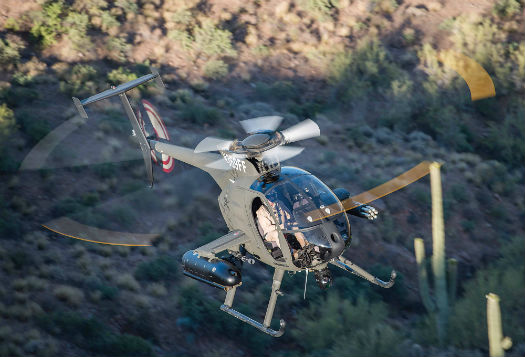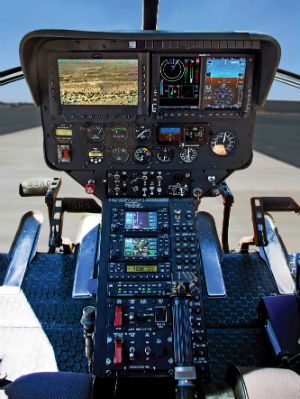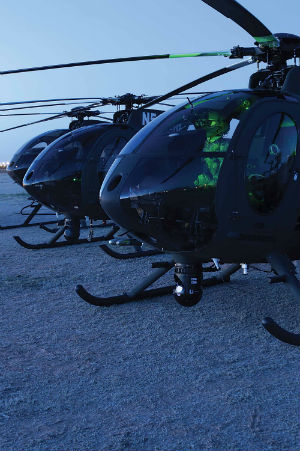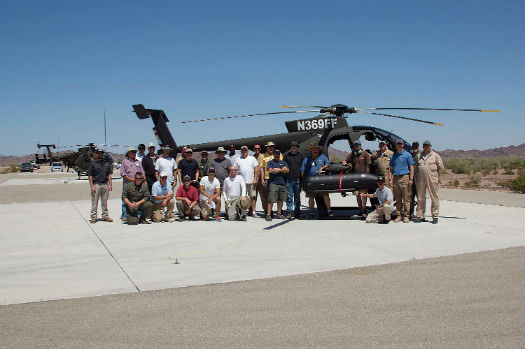
Its ancestors, such as the Hughes OH-6, and more recently the U.S. Army’s MD MH/AH-6M Little Bird, have earned distinguished reputations on the battlefield. Now, MD Helicopters has introduced the MD 530G —
an enhanced performer that incorporates cutting edge technologies and weapon systems. Dan Megna Photos
Various incarnations of the legendary Hughes Model 369 have delighted generations of helicopter pilots in the more than 50 years since the aircraft’s first flight in 1963. Developed for the U.S. Army’s light observation helicopter (LOH) competition (following which it was designated the OH-6A), it spawned the iconic civilian Model 500 series, with current variants including the MD Helicopters, Inc. (MDHI) MD 500D/E, MD 520N and MD 530F. The latest evolution, however — the MD 530G armed aerial scout — sees the aircraft return to its military roots.
The 530G utilizes the same proven airframe, power plant, transmission and dynamic components as its civilian predecessor, the MD 530F, but has been modified to increase performance and payload.
That increased payload allows the 530G to carry some serious artillery; MDHI is promoting the aircraft as a tactical combat asset capable of bringing up to four military weapon systems to the fight, including mini-guns, heavy machine guns, and both unguided and laser guided rockets. Reconfigured, with externally mounted personnel pods, the aircraft can also be used to transport small troop elements.
“Threat levels and active engagements around the world are increasing,” said MDHI CEO Lynn Tilton, explaining the driving force behind the 530G’s development. “We have the capability, and as such, the obligation, to deliver the best available solutions for armed scout and light attack helicopters to the American warfighter and our allies.”
Having spent the better part of my law enforcement career flying Model 500 series, including the 530F, I was interested to experience first-hand how this new military machine handled. And during a recent visit to the MDHI plant in Mesa, Ariz., I was lucky enough to have the opportunity to do just that.

The MD 530G (foreground) is shadowed by an MD 500E from Mace Aviation, which provided support and EO/IR video capabilities during weapon testing at the U.S. Army’s Proving Grounds.
What’s New?
The MD 530G’s program manager, Luke Schmidt, and MDHI production/test pilot Nick Page were my hosts for the visit. During our early morning walk around and preflight, they described the design changes that have created the 530G.
Perhaps the most obvious are the two small carbon fiber and epoxy winglets on each side of the rear cabin. Developed by Mace Aviation, the ER2W Extended Range Weapons Wings (as they are formally known) provide the structures for mounting up to four individual weapon systems, as well as housing an additional 35 gallons of fuel in self-sealing bladders. A small mechanical release at each weapon mounting point provides the pilot with the ability to remotely jettison the weapons stores if necessary.
The foundation of the winglet installation is a mounting structure that’s integrated into the floor of the aircraft. This serves as the universal mount for all the various weapon system components, including ammunition caches for machine guns. The universal mounting structure also holds Moog’s Gen3 Weapon Stores Management System (WSMS) — the small, lightweight computer modules that serve as the heart and brain of the weapon system, handling the vital communications and targeting solutions.
The design concept for the entire rear cabin system is flexibility and versatility. As a result, all of the components, including the WSMS modules, are designed for rapid installation, removal and serviceability in the field.

The cockpit of the MG 530G includes two glass multi-function displays (MFDs). On the left is the EO/IR video display, which includes weapon status and targeting overlays. The right side of the panel is the pilot’s Garmin G500H MFD, and below is back up flight/engine instrumentation.
Another obvious design change from the 530F is the landing gear. Larger skid tubes, assembly and dampeners, adapted from the MD 600, have been engineered to accommodate the 530G’s increased maximum gross takeoff weight (MGTOW) of 3,750 pounds (an additional 650 pounds of payload over the 530F).
The aircraft’s power comes from increased torque limits applied to the Rolls-Royce 250-C30 engine. “We’re looking to increase, through flight test, the torque limits in general for both takeoff and the continuous operations range,” said Schmidt. “We’re not changing the shaft horsepower. We’re really just allowing the torque to have an increased torque limit because there is so much margin built into the TGT limit.”
Moving to the cockpit, I noticed a number of unique modifications. Most obvious is the alteration from the standard civil seating configuration to a right-hand pilot in command (PIC). The panel has also received a makeover, with new instrumentation including Garmin G500H dual glass panel displays and a separate multifunction display for imaging/targeting and weapon status. A slant panel between the seats provides additional space for Garmin 650 GPS/nav/com and control panels for weapon and targeting systems.

The nose-mounted L-3 Wescam MX-10 EO/IR sensor combined with night vision goggle technology will make the MD 530G a fully capable and lethal warfighter after dark.
Getting Airborne
My flight in the Arizona desert took place in late June — and early morning temperatures were already climbing toward triple digits. So, for this flight, we had both front doors removed, giving us a total weight of 3,670 pounds — 80 pounds below MGTOW. The aircraft was “armed” with a full complement of inert weaponry, two each side, including a large pod-mounted machine gun and rockets.
Page discussed how the configuration of the 530G would likely be tailored on the battlefield to meet the various missions for which it may be tasked. “In a scouting role [the aircraft] would be more lightly armed. What we’re seeing today is an aircraft that was set up for [its] ultimate fist fight.”
Engine start was identical to the 530F — manually modulating the fuel flow as the engine spooled up. Once up and running, I turned my attention to the G500’s colorful glass panel display and the location of the relevant information I’d be using during my flight. Mounted in the panel to the left of the G500H is the second multifunction display, and I was impressed with the incredibly detailed color image it showed from the nose-mounted L-3 Wescam MX-10 EO (electro optical) and IR (infrared) sensor. This was displayed along with targeting information from the system’s laser designator. Additionally, an intuitive graphical overlay on the camera image provided information about the status of the various onboard weapons.
With Page at the controls, we lifted off. He casually reminded me to think of this machine as just a standard 530F — albeit a very heavy one. And with that thought freshly imprinted on my brain, I was given control of the aircraft. Immediately, one thing became abundantly clear — this really was a heavy little helicopter.
I took a few minutes to get the feel of things, making gentle banking maneuvers. While the controls felt firm and the aircraft response was smooth and predictable, I didn’t feel the familiar twitchy agility that is characteristic in 500s. It wasn’t necessarily bad; it was just different.

Crews load a 2.75-inch FFAR rocket into the FN Herstal rocket/machine gun pod during testing at Yuma Proving Grounds.
I pulled collective, increasing torque up toward 70 PSI, and pushed the cyclic forward. The aircraft accelerated, but seemed to struggle to attain 100 knots indicated airspeed (KIAS). It was evident how the addition of the wings and the externally mounted weapons were significantly restricting airspeed.
With the 500’s reputation for agility, I proposed a somewhat aggressive series of maneuvers. From a straight and level attitude and 80 KIAS, I initiated what was intended to be a fairly abrupt 60-degree left turn followed by spiraling descent.
The machine entered the maneuver as expected, as if on rails. However, as the bank angle increased, it reached a point where it seemed to “grab” or “dig in,” as if the wing and the weapon stores had perhaps reached some critical angle.
Page wasn’t disturbed in the least, but I found it a curious idiosyncrasy. He then went on to demonstrate a “proper” technique for performing even more aggressive tactical maneuvering, in which the aircraft felt solid and predictable. Page explained the added weight and the aerodynamic effect of the winglets requires more of a finesse approach, as opposed to the extroverted instinctual flying style I perhaps was accustomed to after 20 years as a law enforcement pilot.
I didn’t have the opportunity to explore the aircraft’s autorotational characteristics, but I did perform several approaches to landings at various airspeeds. Again, the additional weight was apparent, but the aircraft and rotor were responsive to all control inputs throughout all phases of the maneuvers. On repeated pick-ups to a hover, and ensuing takeoffs and climb outs — even at nearly 100 degrees with no appreciable wind and our relatively heavy weight — we never reached the 70 PSI torque limit.
Overall, while the aircraft doesn’t necessarily display that nimble agility that one would typically expect in the standard 500 series, I was impressed with the flight characteristics and performance of the MD 530G. But it’s certainly not a machine that will be horsed around with heavy control inputs.

The MD 530G has been engineered for easy configuration and rearming in the field. Here, the ammunition magazine for the Dillon Aero M134 Minigun is readied for its complement of 3,000 rounds.
Testing the Firepower
In June this year, MDHI completed an ambitious series of live fire exercises with the 530G at the U.S. Army’s Yuma Proving Grounds in Arizona. Throughout the evolutions, the aircraft was operated between 3,350 and 3,750 pounds in daytime temperatures near 110 F (43 C). In the end, over 10,000 rounds of machine gun ammunition were fired, along with 47 guided and unguided rockets, including four TALON precision laser guided rockets. The tests were deemed a great success, with program managers, pilots, and engineers enthusiastically praising the performance of the aircraft and the weapon systems.
“We really couldn’t have asked for a better effort,” said Schmidt. “Everything mechanically and electronically worked very, very well.”
The next phase of testing is presently underway, during which engineers will attempt to confirm and verify performance data originally developed back in the ’80s and early ’90s for the U.S. Army’s “Little Bird” program. Once complete, the aircraft will be ready to begin production.
While no launch customer has been announced, MDHI is planning on producing six 530Gs this year with an ambitious schedule of 20 planned for 2015.
With MDHI’s heavy investment in the project, it’s only logical to wonder if perhaps there may be a plan to incorporate any of the 530G’s performance improvements into the civil line.
“We have the ability to go from needs identification to product delivery faster than anyone else in our space,” said Tilton. “Once we have built and delivered our military aircraft, yes, our plan is to evolve the 530G to meet mission growth requirements for civil and parapublic operators.”
Like most every aircraft model produced from the Model 369, the MD530G is a special purpose machine, designed and engineered to operate in a specialized combat role.
For anyone who appreciates the legacy of the little machines, it’s exciting to see how the integration of innovative technology and the latest weapon systems could enable the 530G to push performance and battlefield capabilities to potent new levels.

The MD 530G team at Yuma Proving Grounds. From left: Brendon McCormick, Tim Mallor, Philip Mann, Ryan Doval, Thomas Bastain, Andrew Schafer III, Jerry Colon, Kevin Eaton, Nick Page, Jeremy Lucero, Shawn Adams, Michael Fattey, Robert Nix, Larry Dikens, Jeff Sowers, Marty Anthony, YPG Support Personnel, Jake Shaffer, Tony Avillion, Mark Hughes, John Rankin, Chuck Dean, Marc Larregaray, Jay Wigginton, Luke Schmidy, Dan Colvin, Ryan Mace, Jr. The team represents individuals from MD Helicopters, Moog, Raytheon, FN Herstal, Mace Aviation, L-3 Wescam, Brim Aviation and Dillon Aero.
Dan Megna recently retired after nearly 30 years with one of Southern California’s sheriff’s departments. His last 18 years were spent serving in the department’s aviation unit, where he logged over 8,000 hours in
helicopters as a tactical officer, pilot and flight instructor.





